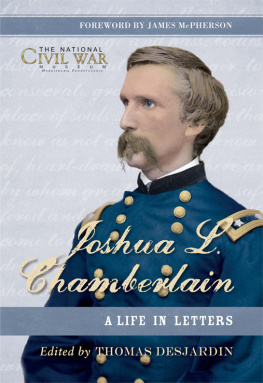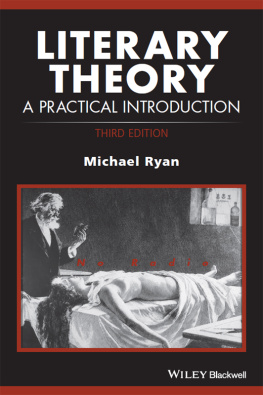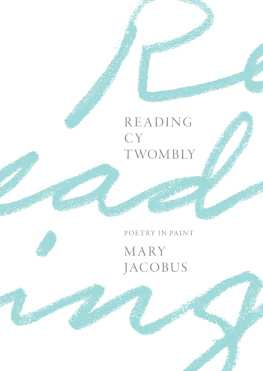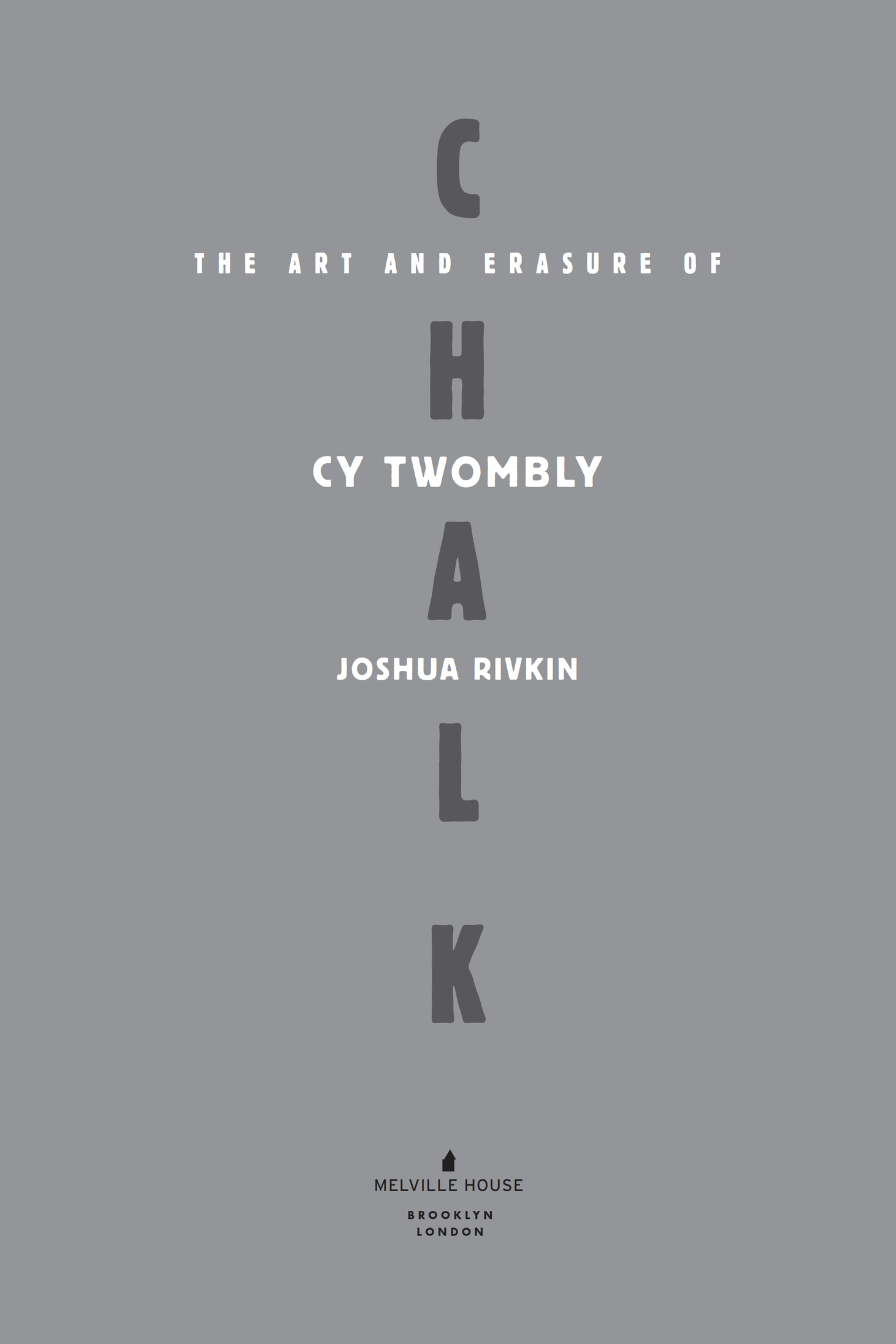16/18 Woodford Rd.
Names: Rivkin, Joshua, author.
Title: Chalk : the art and erasure of Cy Twombly / Joshua Rivkin.
Description: Brooklyn : Melville House, 2018. | Includes bibliographical references and index.
Identifiers: LCCN 2018034338 (print) | LCCN 2018034705 (ebook) | ISBN 9781612197197 (reflow able) | ISBN 9781612197180 (hardback)
Subjects: LCSH: Twombly, Cy, 1928-2011. | ArtistsUnited StatesBiography. | BISAC: BIOGRAPHY & AUTOBIOGRAPHY / Artists, Architects, Photographers. | ART / History / Contemporary (1945-). | BIOGRAPHY & AUTOBIOGRAPHY / Rich & Famous.
Classification: LCC N6537.T96 (ebook) | LCC N6537.T96 R58 2018 (print) | DDC 700.92 [B] dc23
PREFACE
IN THE BLACK
THE SURFACE OF LAKE EDEN is black glass under the press of winter stars. The snow, stopped for now, hangs onto the branches of the pine trees. A young man, Robert Rauschenberg, is alone in the icy water. He hears in the distance the breaking of branches, the hurry of feet through the woods to the lakes edge. His mind, like the sky, is black.
With a single flashlight, the men on the shoreline scan for the shape of arms or a head above water. They call. They wait. They too are shivering. Another young man, Cy Twombly, his friend and fellow student, his lover too, wades out in the cold water and calls him back to dry land. The dark water around Twomblys waist is ice and fire both. I cant catch my breath, he gasps, surprise and worry, not to the others even, but to himself. Hes about to give up, about to turn back. The men with the flashlight think of their own bodies slipping below the water were they to swim out to the young men in trouble, two of them now.
And then Rauschenberg turns back, begins to move towards shore. Twombly calls out to him, This way, this way, warmth and affection in the southern drawl of his voice. He continues to speak his friends name: Bob, this way. They find each other in the water. This way, he says again, softer now, calmer, his speech slow and careful. Cy guides Bob as they move through and out of the lake, black water, slick mud.
Swallowed up by their shivering is their usual talk, easy and joyous, of their art, their ambitions, their plans to travel beyond the small towns of their youth. Any talk about the consequences of what theyre doing, Rauschenbergs wife and child at home in New York, the hurry and foolishness of desire, that is gone too.
They move inside and gather themselves back to warmth; Bob strips down before the fire, while Cy hunches over an electric burner. The moment passes between them and the few others that stood with them at the edge of the lake. A shared spark, a cold terror, a silence. The other students, artists and writers, continue their conversations as if nothing extraordinary has just happened.
The story of this almost drowning comes to us in letters between Robert Creeley and Charles Olson.
Crazy part, that, it all passed into the silences of history, Olson writes to his friend and fellow poet, on the surface, just as though he had gone for a swim and had come out with no help.
After the two young men emerged from the water, Olson, who had recently started running the college at
One is reminded of the crapshoot of memory and history, the endless list of accidents avoidedfires that didnt start, cleaning crews that missed a box, moths that bit their tongues, wars that stayed homethat allowed these letters, any letters, to come down to us in the present, those stray and few gems of Sapphic verse or shards of papyrus that say this happened.
[H]e is in the black, just now, Olson writes of In the black, he writes, as if the young artists life were a thundercloud or a balance sheet or a painted-over canvas.
I noticed a few nights ago Twomblys concern for this boy, he writes, when we were all talking in the study building entrance and Rauschenberg was sitting too carelessly on the railings over the wells edgethat sort of attention, and warning one takes as feminine, guarding the beloved. More than simply capturing the trouble caused by their affair or the near drowning or the uneven state of their young careers, Olsons letters capture the clear affection of Twombly for Rauschenberg, and the older poets dim view of what he describes as these sexually marginal girls & boys. Im struck by the tenderness between the two, the groundwork not just for their short affair but a lifelong friendship.
It was not so felt now, Olson writes, simply, that he, as all of us, had this danger in our mindsSusan Weil who had recently given birth to their son, Christopher. His falling in love with Twombly was certainly part of the reason.
Desire is not simple or safe. In life and in art, desire is the complication. A decade after their time at Black Mountain, Twombly would be the one with a wife and child, just beginning a But when they first met, Nicola was a college student, sixteen years his junior, living across the street from Twomblys Rome apartment, about the same age as those young men in the water back at Black Mountain.
Twomblys marriage, unlike Rauschenbergs, never dissolved. Twombly and his wife, Tatiana Franchetti, remained together and close friends: divided lives under the same roof. Complex arrangements of love and domesticity span all the way from that winter night until the end of his life.
The ghosted memory of those two young men in the water, one saving the other, returns, perhaps, in the wave-like undulation of Twomblys chalkboard paintings or the fire-swept sea of the Lepanto series. Not in any direct wayand certainly not for every viewerbut it echoes, that night, This way, this way.
I cant help but think of his paintings named for Hero and Leander, canvases of lush, impasto pinks and whites. Leander, who nightly swims across the Hellespont to his beloved Hero, drowns. Hero in her sorrow, throws herself into the water to join his fate. That old story: two young lovers, star-crossed, perish together rather than live apart. Twombly named multiple paintings after doomed pairs who have lost each other, or are just about to: Orpheus and Eurydice, Narcissus and Echo, Acis and Galatea, Achilles and Patroclus.
In Achilles Mourning the Death of Patroclus 1962, two cloudbursts chase each other across the canvas, one a deep crimson, the other a lighter red, almost pink, washed out with white. If one is rage, the other is absence. The red is the red of blood and violence. Of loss. Storms of paint touch and drift apart like those boys in the lake. The very title of the painting is handwritten below the shapes, and then crossed out by the same anxious hand.
Grief over the lost belovedcaught in the gerund mourningis ongoing in the painting of Achilles and Patroclus, a passage of loss, an emotional drama of trying to hold onto what slips away. Not the past-tense myth of history books, this is an event as alive and emotional now as it was thousands of years ago.








